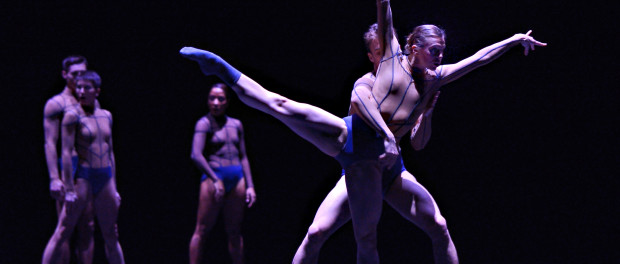Ballet BC Captivates Montreal with Three Choreographers
 AURA. Danse Danse. Photo © Michael Slobodian. Dancers Alexis Fletcher, Peter Smida and Ballet BC artists
AURA. Danse Danse. Photo © Michael Slobodian. Dancers Alexis Fletcher, Peter Smida and Ballet BC artists
Ballet BC stunned Montreal audiences this week with their triple bill featuring the work of three European choreographers. Each work was unique in style, but together they flaunted the extraordinary talent of these west coast dancers.
The evening, part of the Danse Danse season, opened with Italian choreographer Jacopo Godani’s A.U.R.A. (Anarchist Unit Related to Art). A cast of androgynous spage-age primitives gave the impression of performing various rituals en masse as well as in small groups. Movements alternated between the classically inclined and the more starkly modern, lyrically undulating bodies crescendoing into a frenzy of mechanically repetitive motions. At times I had the impression that the dancers were cyborg-like machines, doing a pretty good job imitating human beings. This feeling was only emphasized when racks of starkly fluorescent overhead lights descended, coming close enough to the performers to give the impression that they were recharging for the next round. Both the lighting and the music—primarily electronic but at times featuring recorded acoustic instruments—contributed to the slightly alien effect of the movements.
The second work, the award-winning Walking Mad by Swedish choreographer Johan Inger, was much warmer and more fanciful than the first. Against Ravel’s triumphant Bolero, men and women act out the eternal games played by humans — fun and parties and flirting and sex and loneliness and jealousy. Using a mobile wooden wall, with doors that open and close, including but also excluding, the piece reveals our inner life as eternally bumbling college students trying to find gratification in our interactions with others. However things get real when the music switches to Arvo Pärt’s haunting Für Alina, and the man and woman who have already been marked as outsiders attempt, perhaps unsuccessfully, to find a real sense of intimacy and connection, before the man disappears over the wall.
Finally, in the theatrical Petite Cérémonie by French choreographer Medhi Walerski, men and women try to find their place among each other, sometimes moving in tandem, sometimes breaking out individually, but always somehow giving an impression of coherence and equilibrium. The work starts during intermission: while the house lights are still on and people haven’t yet returned from the break, stagehands sweep a completely exposed stage. The work begins with one dancer at a time joining a growing line of people moving simply from side to side. One by one the backdrops and side curtains fall. We get the impression that the performers, dressed in tuxes and black dresses, are the audience, waiting for something interesting to happen. Eventually, of course, the house lights go down and the choreography becomes gradually more complicated. Later, in another theatrical move, one of the male dancers expounds on the difference between the sexes: men are boxes, women are cables. Juggling and moving while talking, he explains that men can’t multi-task. By the end we get the impression that the dancers have found their places both as individuals and as part of the group.
Ballet BC performed at Théâtre Maisonneuve at Place des Arts as part of the Danse Danse season 22-24 January.





